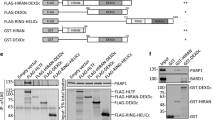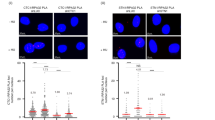Abstract
Replication protein A (RPA) is a eukaryotic single-stranded DNA-binding protein consisting of three subunits of 70-, 32-, and 14-kDa (RPA70, RPA32, RPA14, respectively). It is a protein essential for most cellular DNA metabolic pathways. Checkpoint proteins Rad9, Rad1, and Hus1 form a clamp-like complex which plays a central role in the DNA damage-induced checkpoint response. In this report, we presented the evidence that Rad9–Rad1–Hus1 (9–1–1) complex directly interacted with RPA in human cells, and this interaction was mediated by the binding of Rad9 protein to both RPA70 and RPA32 subunits. In addition, the cellular interaction of 9–1–1 with RPA or hyperphosphorylated RPA was stimulated by UV irradiation or camptothecin treatment in a dose-dependent manner. Such treatments also resulted in the colocalization of the nuclear foci formed with the two complexes. Consistently, knockdown of the RPA expression in cells by the small interference RNA (siRNA) blocked the DNA damage-dependent chromatin association of 9–1–1, and also inhibited the 9–1–1 complex formation. Taken together, our results suggest that 9–1–1 and RPA complexes collaboratively function in DNA damage responses, and that the RPA may serve as a regulator for the activity of 9–1–1 complex in the cellular checkpoint network.
This is a preview of subscription content, access via your institution
Access options
Subscribe to this journal
Receive 50 print issues and online access
$259.00 per year
only $5.18 per issue
Buy this article
- Purchase on Springer Link
- Instant access to full article PDF
Prices may be subject to local taxes which are calculated during checkout





Similar content being viewed by others
References
Abraham RT . (2001). Genes Dev, 15, 2177–2196.
Bao S, Lu T, Wang X, Zheng H, Wang LE, Wei Q, Hittelman WN and Li L . (2004). Oncogene, 23, 5586–5593.
Bartek J, Lukas C and Lukas J . (2004). Nat. Rev. Mol. Cell Biol., 5, 792–804.
Bermudez VP, Lindsey-Boltz LA, Cesare AJ, Maniwa Y, Griffith JD, Hurwitz J and Sancar A . (2003). Proc. Natl. Acad. Sci. USA, 100, 1633–1638.
Binz SK, Sheehan AM and Wold MS . (2004). DNA Repair (Amsterdam), 3, 1015–1024.
Bochkarev A and Bochkarev E . (2004). Curr. Opin. Struct. Biol., 14, 36–42.
Bochkarev E, Korolev S, Lees-Miller SP and Bochkarev A . (2002). EMBO J., 21, 1855–1863.
Burtelow MA, Kaufmann SH and Karnitz LM . (2000). J. Biol. Chem., 275, 26343–26348.
Burtelow MA, Roos-Mattjus PM, Rauen M, Babendure JR and Karnitz LM . (2001). J. Biol. Chem., 276, 25903–25909.
Carty MP, Zernik-Kobak M, McGrath S and Dixon K . (1994). EMBO J., 13, 2114–2123.
Caspari T, Dahlen M, Kanter-Smoler G, Lindsay HD, Hofmann K, Papadimitriou K, Sunnerhagen P and Carr AM . (2000). Mol. Cell. Biol., 20, 1254–1262.
Costanzo V, Shechter D, Lupardus PJ, Cimprich KA, Gottesman M and Gautier J . (2003). Mol. Cell, 11, 203–213.
Dart DA, Adams KE, Akerman I and Lakin ND . (2004). J. Biol. Chem., 279, 16433–16440.
Ellison V and Stillman B . (2003). PLoS Biol., 1, E33.
Iftode C, Daniely Y and Borowiec JA . (1999). Crit. Rev. Biochem. Mol. Biol., 34, 141–180.
Kastan MB and Bartek J . (2004). Nature, 432, 316–323.
Komatsu K, Miyashita T, Hang H, Hopkins KM, Zheng W, Cuddeback S, Yamada M, Lieberman HB and Wang HG . (2000). Nat. Cell Biol., 2, 1–6.
Lee SE, Moore JK, Holmes A, Umezu K, Kolodner RD and Haber JE . (1998). Cell, 94, 399–409.
Lindsey-Boltz LA, Bermudez VP, Hurwitz J and Sancar A . (2001). Proc. Natl. Acad. Sci. USA, 98, 11236–11241.
Lindsey-Boltz LA, Wauson EM, Graves LM and Sancar A . (2004). Nucleic Acids Res., 32, 4524–4530.
Liu Y, Yang Z, Utzat CD, Liu Y, Geacintov NE, Basu AK and Zou Y . (2005). Biochem. J., 385, 519–526.
Longhese MP, Neecke H, Paciotti V, Lucchini G and Plevani P . (1996). Nucleic Acids Res., 24, 3533–3537.
Lowndes NF and Murguia JR . (2000). Curr. Opin. Genet. Dev., 10, 17–25.
O’Connell MJ, Walworth NC and Carr AM . (2000). Trends Cell Biol., 10, 296–303.
Pan ZQ, Park CH, Amin AA, Hurwitz J and Sancar A . (1995). Proc. Natl. Acad. Sci. USA, 92, 4636–4640.
Parrilla-Castellar ER, Arlander SJ and Karnitz L . (2004). DNA Repair (Amsterdam), 3, 1009–1014.
Pellicioli A, Lee SE, Lucca C, Foiani M and Haber JE . (2001). Mol. Cell, 7, 293–300.
Rauen M, Burtelow MA, Dufault VM and Karnitz LM . (2000). J. Biol. Chem., 275, 29767–29771.
Robison JG, Elliott J, Dixon K and Oakley GG . (2004). J. Biol. Chem., 279, 34802–34810.
Roos-Mattjus P, Hopkins KM, Oestreich AJ, Vroman BT, Johnson KL, Naylor S, Lieberman HB and Karnitz LM . (2003). J. Biol. Chem., 278, 24428–24437.
Rouse J and Jackson SP . (2002). Science, 297, 547–551.
Shell SM, Hess S, Kvaratskhelia M and Zou Y . (2005). Biochemistry, 44, 971–978.
Sun Z, Hsiao J, Fay DS and Stern DF . (1998). Science, 281, 272–274.
Sunnerhagen P and Carr AM . (2000). Mol. Cell. Biol., 20, 1254–1262.
Vassin VM, Wold MS and Borowiec JA . (2004). Mol. Cell. Biol., 24, 1930–1943.
Venclovas C and Thelen MP . (2000). Nucleic Acids Res., 28, 2481–2493.
Volkmer E and Karnitz LM . (1999). J. Biol. Chem., 274, 567–570.
Wang L, Hsu CL, Ni J, Wang PH, Yeh S, Keng P and Chang C . (2004). Mol. Cell. Biol., 24, 2202–2213.
Wold MS . (1997). Annu. Rev. Biochem., 66, 61–92.
Yaffe MB and Elia AE . (2001). Curr. Opin. Cell Biol., 13, 131–138.
Yang ZG, Liu Y, Mao LY, Zhang JT and Zou Y . (2002). Biochemistry, 41, 13012–13020.
Yoshida K, Komatsu K, Wang HG and Kufe D . (2002). Mol. Cell. Biol., 22, 3292–3300.
Yoshida K, Wang HG, Miki Y and Kufe D . (2003). EMBO J., 22, 1431–1441.
You Z, Kong L and Newport J . (2002). J. Biol. Chem., 277, 27088–27093.
Yu X, Chini CC, He M, Mer G and Chen J . (2003). Science, 302, 639–642.
Zhou BB and Elledge SJ . (2000). Nature, 408, 433–439.
Zou L, Cortez D and Elledge SJ . (2002). Genes Dev., 16, 198–208.
Zou L and Elledge SJ . (2003a). Science, 300, 1542–1548.
Zou L, Liu D and Elledge SJ . (2003b). Proc. Natl. Acad. Sci. USA, 100, 13827–13832.
Acknowledgements
We thank Drs Antonio E Rusinol and Krishna Singh for their assistance in immunofluorescence technique. We also thank Dr Deling Yin for helpful suggestions on siRNA experiments. This study was supported by NCI Grant CA86927 (to YZ).
Author information
Authors and Affiliations
Corresponding author
Rights and permissions
About this article
Cite this article
Wu, X., Shell, S. & Zou, Y. Interaction and colocalization of Rad9/Rad1/Hus1 checkpoint complex with replication protein A in human cells. Oncogene 24, 4728–4735 (2005). https://doi.org/10.1038/sj.onc.1208674
Received:
Revised:
Accepted:
Published:
Issue Date:
DOI: https://doi.org/10.1038/sj.onc.1208674
Keywords
This article is cited by
-
Revisiting regulatory roles of replication protein A in plant DNA metabolism
Planta (2021)
-
Enhancer of mRNA Decapping protein 4 (EDC4) interacts with replication protein a (RPA) and contributes to Cisplatin resistance in cervical Cancer by alleviating DNA damage
Hereditas (2020)
-
Impact of DNA repair and stability defects on cortical development
Cellular and Molecular Life Sciences (2018)
-
Molecular basis for PrimPol recruitment to replication forks by RPA
Nature Communications (2017)
-
TLK1B mediated phosphorylation of Rad9 regulates its nuclear/cytoplasmic localization and cell cycle checkpoint
BMC Molecular Biology (2016)



